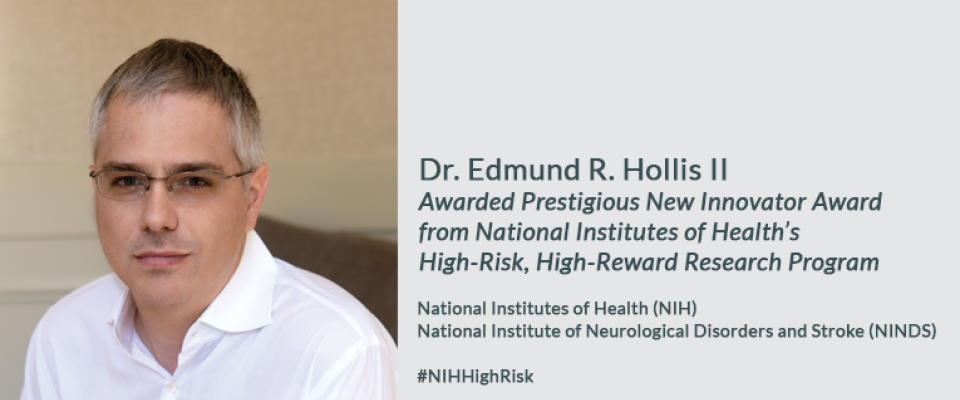You are here

Dr. Edmund R. Hollis II Awarded Prestigious New Innovator Award from the National Institutes of Health’s High-Risk, High-Reward Research Program and to Receive $2,775,000 in NIH Funding
Dr. Edmund R. Hollis II, Director of the Circuit Repair Laboratory at the Burke Medical Research Institute, is one of fifty-five early career scientists across the United States to be awarded the NIH Director’s New Innovator Award, part of the National Institutes of Health’s (NIH) High-Risk, High-Reward Research program. The NIH Director’s New Innovator Award, established in 2007, supports unusually innovative research from early career investigators who are within 10 years of their final degree or clinical residency and have not yet received a research project grant or equivalent NIH grant.
As part of the prestigious New Innovator Award, the NIH has awarded a grant in the amount of $2,775,000 to the Burke Medical Research Institute to fund Dr. Hollis’ project “Modulation of cortical networks, a new approach to spinal cord injury rehabilitation”. Dr. Hollis’ research project will address the ability to learn new skills (i.e. eating with chopsticks, playing the piano) that depend on the malleability of motor areas in the brain. “As humans and animals learn new skills, neurochemical processes alter the brain’s motor map, strengthening areas used in the new skill. Our proposal uses state-of-the-art techniques to determine how these neurochemical processes can aid in the recovery from spinal cord injury,” said Dr. Hollis. “This will have far reaching importance in developing treatments for individuals living with spinal cord injury.”
“Millions of Americans with paralysis suffer from poor quality of life despite our ability to keep them alive longer. Accordingly, understanding how brain circuits subserving movement can be repaired after injury is one of the most fundamental challenges to improving health span in the United States. Dr. Hollis plans to leverage the remarkable support from the National Institutes of Health Director’s New Innovator Award to develop strategies for stimulating and monitoring the repair of circuits underlying movement after spinal cord injury in living animals,” said Dr. Rajiv R. Ratan, Executive Director of the Burke Medical Research Institute. “These exciting and innovative studies promise to provide a much-needed path towards curing paralysis not only in spinal cord injury, but in stroke and traumatic brain injury as well.”
This year, the National Institutes of Health’s (NIH) High-Risk, High-Reward Research program, part of the NIH Common Fund, funded 86 awards to exceptionally creative scientists proposing to use highly innovative approaches to tackle major challenges in biomedical research. The program supports high-risk ideas with high-impact potential, such as recording the history of an individual cell in its DNA for future playback; understanding how bacteria in the microbiome can share anti-drug-resistance genes among themselves; resetting the immune system to allow universal organ transplants; and reimagining clinical trials to make them more personalized and more effective.
The program accelerates scientific discovery by supporting high-risk research proposals that may not fare well in the traditional peer review process despite their potential to advance the field. Applicants of the program are encouraged to think outside-the-box and to pursue exciting, trailblazing ideas in any area of research relevant to the NIH mission.
“I continually point to this program as an example of the creative and revolutionary research the NIH is supporting,” said NIH Director Francis S. Collins, M.D., Ph.D. “The quality of the investigators and the impact their research has on the biomedical field is astounding. I always look forward to seeing what the new awardees are proposing and to watching how it is accomplished over the years.”
In 2017, the NIH issued 12 Pioneer awards, 55 New Innovator awards, 8 Transformative Research awards, and 11 Early Independence awards. The 2017 awards total approximately $263 million and represent contributions from the NIH Common Fund; National Institute of General Medical Sciences; National Institute of Mental Health; National Center for Complementary and Integrative Health; and National Institute of Dental and Craniofacial Research.
About the NIH Award Support:
Dr. Hollis’ research project will be supported by the National Institutes of Health Award Number DP2NS106663, which will be administered by the National Institute of Neurological Disorders and Stroke.
About the NIH Common Fund:
The NIH Common Fund encourages collaboration and supports a series of exceptionally high-impact, trans-NIH programs. Common Fund programs are managed by the Office of Strategic Coordination in the Division of Program Coordination, Planning, and Strategic Initiatives in the NIH Office of the Director in partnership with the NIH Institutes, Centers, and Offices. More information is available at the Common Fund website: https://commonfund.nih.gov.
About the National Institutes of Health (NIH):
NIH, the nation's medical research agency, includes 27 Institutes and Centers and is a component of the U.S. Department of Health and Human Services. NIH is the primary federal agency conducting and supporting basic, clinical, and translational medical research, and is investigating the causes, treatments, and cures for both common and rare diseases. For more information about NIH and its programs, visit www.nih.gov.
NIH…Turning Discovery Into Health®
About the Burke Medical Research Institute:
Burke Medical Research Institute (BMRI) is a nonprofit leading scientific research institute devoted to advancing the study of neurological diseases and injuries, pioneering novel rehabilitation therapies and developing innovative clinical programs and clinics. Based at Burke Rehabilitation Hospital and working synergistically with its academic affiliate Weill Cornell Medicine, BMRI is comprised of several neurological disease, injury and functional recovery focused research laboratories.
CONTACTS:
Rachel Britt, Ph.D
NIH Common Fund
(301) 435-0968
Christine E. Hughes
Vice President of Institutional Advancement
Burke Medical Research Institute
(914) 368-3142

